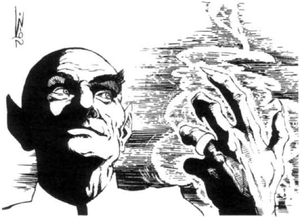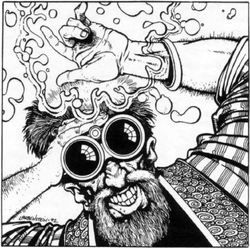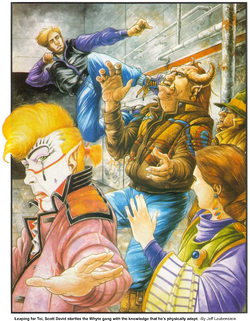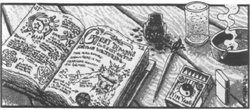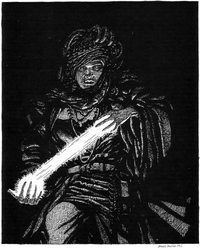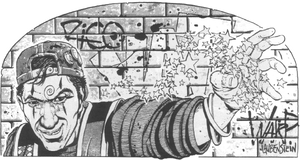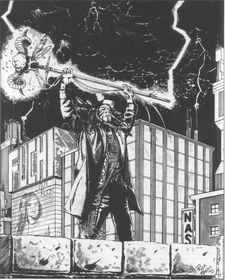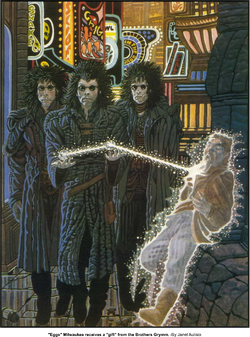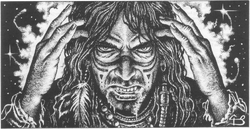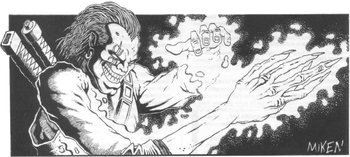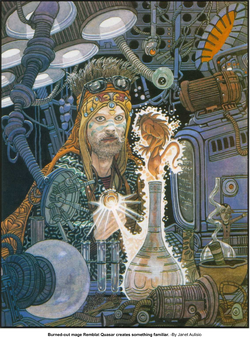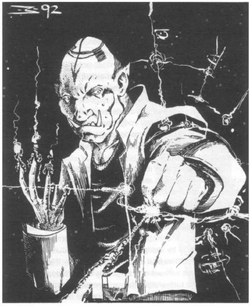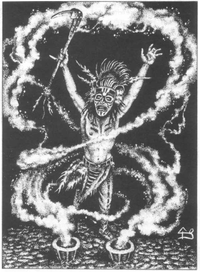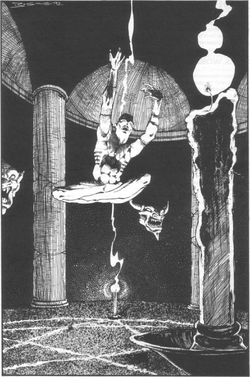Magic Primer
Magic Users
Magic users, also known as magicians or the awakened, wield magic power through one of three traditions: hermeticism, shamanism, and physical kineticism.
Hermetic Mages
A character who chooses the hermetic tradition becomes a mage. A mage sees the universe as a pattern of abstract forces and energies that can be controlled through complex symbols and formulae of power. Where shamanism is intuitive and improvisational, hermetic magic is more intellectual in its approach, relying on observation, theory, practices, and precise execution. Their magic is based on a complicated set of theories that describe the way astral space contracts and intersects with the physical world. As one might expect, there are as many versions of these theories as there are mages.
Though some magicians may like the country life, stereotypically they are urban types. Mages are scholars and often have elaborate libraries and equipment to assist their research and practice.
Hermetic Origins
Hermetic magic attracted much interest before the Awakening. Occultists, mystics, ceremonial magicians, surprisingly large numbers from all walks of life were studying the disciplines of the mage at the time of the Awakening, reacting variously with surprise, relief, or even dismay to discover that the magic suddenly worked. As hermetic magic requires complex, intellectual, abstract thinking, many of those who awakened to its practice were corporate employees–scientists, analysts, researchers–hobbyists studying magic in their spare time. As such, the corporations picked up on hermetic magic very early on. To this day the corporations employ wage mages in all capacities, but there are very few shamans. (Try telling Coyote he can only have an hour for lunch.)
Shamans
A character who chooses the shamanic tradition becomes a shaman. Shamans receive their power through linking their own inner world of emotion, will, and faith with the external world of nature. This link with nature is personified through a totem, an animal figure that exemplifies the shaman's beliefs and way of life. Totems choose the shaman, waiting for the potential shaman to either heed the call or reject it, such as by choosing an alternate awakened path. Players should also note that a totem is not just a "bear" or even "the bear." The totem is Bear, the archetype for all bears in the world. A totem is not just an animal, but the essence, or true spirit, of that animal.
Shamans are in tune with the ways of nature and life. They are concerned with the maintenance and preservation of their environment, be it the wilds of the Pacific Northwest. the expanse of the Sahara, the majesty of the Amazon rain forests, or the wonderfully complex ecosystem that is a modern city. All is nature, whether it be rocks, streams, trees, and animals, or concrete, steel, neon, and humanity.
Before the awakening, those practicing shamanic traditions would often wear masks to embody their totem. While some still wear them, they are no longer necessary. When a shaman performs magic, the physical traits associated with the totem become more apparent in him. The more powerful the magic, the more noticeable these animal traits become. This is a matter of appearance, not an actual shapechange, and is only visible to the living and spirits. A minor spell might cause an Eagle shaman's features to take on a sharper cast, while with the most powerful spells their features might completely dissolve within the image of a mighty eagle's head.
Shamanism Origins
A shaman's magic comes from the world of nature and the power of emotions. In days past, some "civilized" scholars disparaged shamanism, calling it "primitive" nature worship. When the Awakening came, however, these "backward" primitives knew how to use their new power to pay back the governments and corporations that had oppressed their people for so long. Indeed, shamanism had developed even among some city-dwellers during the boom in occultism at the close of the 20th century. When the magic came back, these "urban shamans" found that the old ways worked well in cities, too.
Physical Adepts
A character who walks the path of physical kinetic discipline becomes a physical adept. A physical adept is concerned with mastery and perfection of the physical body in order to achieve a state of inner harmony. A physical adept can do little that does not directly involve their own body, but that is usually enough.
Kineticism Origins
A physical adept is dedicated to improving the body and its abilities. Powers attributed to legendary martial artists, warriors of shamanic peoples, berserkers, and the like, suggest that such adepts may have existed before the Awakening. The first publicly documented physical adept in modern times was Francis Daniels, an engineering Ph.D. and fourth dan ki-aikido black belt. Much of the current understanding of the abilities of the physical adept are due to research Daniels conducted before his untimely death in the riots attending the collapse of the U.S. government in the Washington D.C. metroplex in 2030.
Magic Lodges
A magic lodge is a stationary collection of symbols, writings, tools, fetishes, and other mystical materials that helps spellcasters record their lore, expand their talent, and practice magic. It’s a basic tool of magicians across the world, about the size of a room. They need it to learn spells, perform rituals, and craft foci. In a pinch they can use it to protect themselves from magical threats. Each lodge is of a specific tradition—a shamanic lodge is intended for shamans, and a hermetic lodge for mages.
Magical lodges aren't particularly portable, taking several days to set up and using several thousand nuyen of materials. These materials can be reused when a lodge is moved.
Hermetic Libraries
Mages spend a lot of time doing research. They need extensive reference libraries for many activities: learning new spells, designing magical rites, summoning spirits, and so on. The specific contents determine its useful at various tasks, with different mages varyingly specializing their libraries in sorcery, conjuring, magical theory, etc.
Mages can share libraries. Access to the thaumaturgical section of any big university library or corporate reference department lets any number of mages pursue projects at the same time.
A mage may make use of multiple libraries. A hermeticist might maintain a small personal library at home, barely more than a few books on a shelf and a collection of datachips, while making use of a larger, shared research library for more in-depth research.
Medicine Lodges
The medicine lodge is the sacred place of the shaman. It is a little, isolated world where powerful magics can be worked and it is a place for communication with the spirits. Here is where the shaman keeps the special items that are actually and symbolically powerful for him. It is the place where the world of the shaman bridges the worlds of the magical and the mundane.
Shamans generally set up their medicine lodges in an environment to the shaman's totem. A Bear lodge is traditionally set up in the forest, a Turtle lodge along the water, a Bat lodge within a cave. However, some shamans, particularly urban shamans, will create lodges that recreate elements of their spirit's natural environment in order to make their totem spirit more comfortable. An urban Kangaroo shaman may cultivate eucalyptus and palm lily, while an inland Shark shaman would surround themselves with aquariums.
Shamanic lodges may be shared between shamans of the same totem, though the spirit will expect a more elaborate lodge the larger the group of shamans. Many Native American tribes maintain elaborate permanent lodges, be it a hogan, teepee, kiva, cave, or pueblo, for rituals, spiritual communion, and other group activities.
A shaman may make use of more than one medicine lodge. For example, an urban shaman of a non-urban totem may maintain a modest home lodge for simple ritual casting and spirit communion, while making use of a more elaborate and extensive nature lodge for learning new spells and other tasks involving deeper contemplation.
Training Sanctuaries
Sorcery
Sorcery is the art of spellcasting. Through it, a magician can command and shape the forces of astral space to a specific end.
Hermetic Spellcasting
Hermetic mages command the astral forces through very specific, practiced, precise formulas. Most of the effort is mental; the exercise of commanding the forces is a task of mental gymnastics and willpower. Some physical activity accompanies the spell, but it is minor compared to the work the mage's mind is doing. Perhaps some words must be spoken, a minor gesture be made, or some symbolic material be used in some manner. Regardless, the mage calls up the mental multidimensional image of the spell formula, imposes it on the forces of reality at hand, then shapes, channels, and directs them to the desired end. The casting of a particular spell is an identical procedure each and every time, unless some parameter of the spellcasting has changed.
Shamanic Spellcasting
Shamans, however, rarely cast magic the same way twice. Their magic comes from intuition, improvisation, and an understanding of the moment. The forces of nature are called, not commanded. The shaman considers the forces of nature to be allies, not tools, allies to be praised for their assistance. The specifics of a shaman's spellcasting vary with the moment and the situation. The calling of powers is very personal and must be tailored to the situation. Each dance, each chant, each song is different because each moment is different. Thus, each spellcasting is different. Like the mage, the shaman uses his mind to call on the unseen forces of magic, but his spellcasting has more external components in the form of dances, gestures, chants, or songs. Most of this is voluntary, however. When necessary, the shaman can call the forces of nature with barely a whisper.
Types of Spells
Physical spells affect physical things. The magical energies of a physical spell are synchronized with the tangible aspects of a target: its composition, mass, momentum, appearance, and so on. Only physical spells can affect inanimate objects such as walls. rocks, and the like. Physical spells can affect living things, but they affect the physical nature and structure of the being.
Mana spells affect the intangible elements of a target, such as the spirit or emotions. They are the only spells that can affect purely magical targets. Mana spells cannot affect inanimate objects on any level.
Spell Categories
Combat spells are quick, dirty, and violent. The energy of combat spells is channeled into the target directly from astral space through the target's aura. The target is, effectively, attacked from within. Combat spells ignore the effects of armor and non-magical, external protections. The target of a combat spell must, however, be within line-of-sight of the casting magician. The magician must be able to see the target, directly. The magician can ignore transparent obstructions such as clear glass, but not smoked or one-way glass. If the magician cannot see the target, he cannot affect the target, even if he is absolutely certain that the target is there, just out of line-of-sight.
Detection spells are used to enhance the senses or to analyze the environment. They allow the magician, or the recipient of the spell, to sense things in a manner normally beyond his or her ability, to see or hear from a great distance, and so on. There are also spells that allow the magician to detect the presence of other beings, magic, life, and enemies.
Health spells are concerned with the condition and performance of the body. They can be used to treat or heal injuries, purge poisons or toxins from a body, or improve physical performance.
Illusion spells fool the senses. They can be used to deceive, create things that do not really exist, make things invisible, stimulate the senses, or provide simple or complex entertainment.
Manipulation spells can transform, transmute, control, or animate matter or energy. They are powerful, complex spells that are difficult to control and master. Manipulation spells can control the emotions or actions of a person, move objects or items, shape, create, or channel energy such as light or fire, or change a target's form or appearance by changing its structure. Unlike combat spells, a manipulation spell used for a violent, destructive purpose actually creates a tangible physical effect. A blast of flame from a manipulation spell strikes the target from the outside, which lets the target benefit from the protection of armor and such. Combat spells strike from within, bypassing armor. Manipulation spells, however, do not have the same line-of-sight restrictions as combat spells.
Spell Targeting
In choosing a target or targets, the magician can choose anything within sight. Sight is the key concept. Magicians cannot directly affect what they cannot see. Binoculars, glasses, telescopes, and other devices can enhance vision for spellcasting, as can any magic or technology that penetrates darkness.
A magician cannot, however, cast spells directly at invisible beings or beings in astral space except by using enhanced vision or astral perception, as appropriate. Remote vision, such as through a telecom screen, security camera, or a remote-sensing spell like clairvoyance are also useless for casting spells.
A good rule of thumb is that magicians must be able to see their targets with their own eyes or a natural extension of those eyes. The image of the target must be the original image; nothing that translates the image into another medium works. So, optical binoculars work fine for spellcasting, but electronic binoculars that digitize the light from the image and computer-enhance it would not work.
Mirrors work fine, and transparent glass is no hindrance, but unless the mage is on the "see-through" side of a one-way mirror, that would not work either. Cybereyes work because the magician has invested their essence into them. The remote cameras of a drone, however, would not work.
Possible Mechanical Modifiers
Magicians may stack multiple spells into one long spell and then cast them simultaneously. While this is at greater difficulty (mechanically, they'll generally take Disadvantage), it can allow them to simultaneously produce complex combined effects.
Similarly, sustaining an ongoing spell, absent a sustaining focus, requires mental attention. This makes it more difficult to cast a second spell with a first already going (mechanically, generally inflicting Disadvantage).
Injury, disability, or impairment affecting the ability to concentrate can disadvantage spellcasting.
Difficulties perceiving a target can disadvantage spellcasting. See Spell Targeting.
While armor or other physical protection doesn't generally affect spells, magical protection, such as from a mana barrier, may disadvantage spellcasting. Mages that erect such a barrier are not disadvantaged by it.
Casting spells from within a magic circle or magic lodge by anyone other than the mages or shamans who created or maintain it is disadvantageous.
Spells with a touch requirement (hand-to-hand physical contact must be made) are disadvantaged by any difficulties in touching the target.
Noticing Spellcasting
Just how obvious is spellcasting? Not very, unless the observer knows what they are looking at and is paying attention.
Magicians and others families with spellcasting find it easier to notice, particularly magicians of the same tradition who are familiar with the type of spell being cast. More powerful spells (producing larger effects, affecting larger groups) are more noticeable, less powerful less noticeable.
Independent of the above, an astrally projecting or perceiving character automatically notices the colorful astral display associated with spellcasting.
Learning Spells
Before a magician can cast a spell, it must be learned. It can be learned from another magician who already knows it or designed from a spell formula.
The cost of learning a spell includes acquiring a teacher or formula, acquiring magical materials used in the process of study, and the time and effort invested in studying.
To learn a spell, a shaman must spent time in their medicine lodge practicing it. Similarly, a hermetic mage must spent time practicing in their hermetic library.
A shaman learning a new spell spends time chanting, dancing, and carrying on. This whips up the kind of emotional peak shamans need to contact the spell energy. A mage spends time in meditation, intense study, and formal ritual. For either, learning a spell requires a week or two.
Shamans and mages make bad neighbors and worse roommates. The differences between "hermetic nerds" and "party shamans" are a running gag on the popular trivid series "The Odd Coven".
– Dowd
Kinetics
Conjuring
Ritual Sorcery
Ritual sorcery is an alternative method of performing sorcery. While much slower, requiring hours to perform, rituals allow multiple magicians to cooperate, can produce effects over wider areas, and otherwise affect more people are perform more difficult tasks. Perhaps most usefully, they also allow magicians to cast spells on targets that are not within visual range.
Magic Circles
Ritual sorcery requires a magic circle to be performed, whether a hermetic circle or shamanic circle. A magic circle is specific to a particular tradition (hermeticism or shamanism) and to the specific spell or conjuring being performed. A magic circle for a stink spell can't be used to perform a healing spell. A magic circle for summoning a fire elemental can't be used to summon a water elemental.
A circle can be in any convenient, private place, indoors or out, thought it should be secluded so as to allow the ritualists to focus. Circles require the use of both reusable and one-time resources. A magician can draw on the resources of an appropriately-stocked magic lodge for the reusable components. The cost of the one-time components are:
- Detection and Illusion rituals cost 500-2k¥ for each cast.
- Health rituals cost 2.5k-10k¥ for each cast.
- Manipulation rituals cost 5k-20k¥ for each cast.
- Combat spells cannot be cast using rituals.
The ritual cost is higher for larger effects and larger numbers of targets. Casting the ritual uses up the materials, regardless of the outcome.
Ritual Targeting
If the magician cannot see the target, they need a material link to perform ritual sorcery. If the target is a living being, the material link is a tissue sample that contains the being's DNA pattern. If the target is not a living being, the magician needs an integral piece of its structure. The magician could, for example, target a building using a brick pried from one of its walls, but they could not use a picture that once hung inside.
If a ritual team is involved in the spellcasting, however, one of its members can astrally guide the spell toward its target, making a material link unnecessary. See astral guiding.
Ritual Teams
Ritual sorcery lets magicians cooperate in casting a spell. The magicians must belong to the same tradition, but shamans of different totems may cooperate in a ritual team. Physical adepts may not lead ritual sorcery, but may assist it; physical adepts that learn to assist in ritual sorcery must select either shamanic or hermetic magic as their associated tradition.
Astral Guiding
In astral guiding, an astrally-projecting team member is used to "spot" the target in astral space, making a material link unnecessary. This team member does not provide assistance (e.g., Helping or Advantage) other than this guidance. The guiding team member must be physically present at the ritual casting and project to maintain astral line-of-sight to the target for the duration of the ritual.

